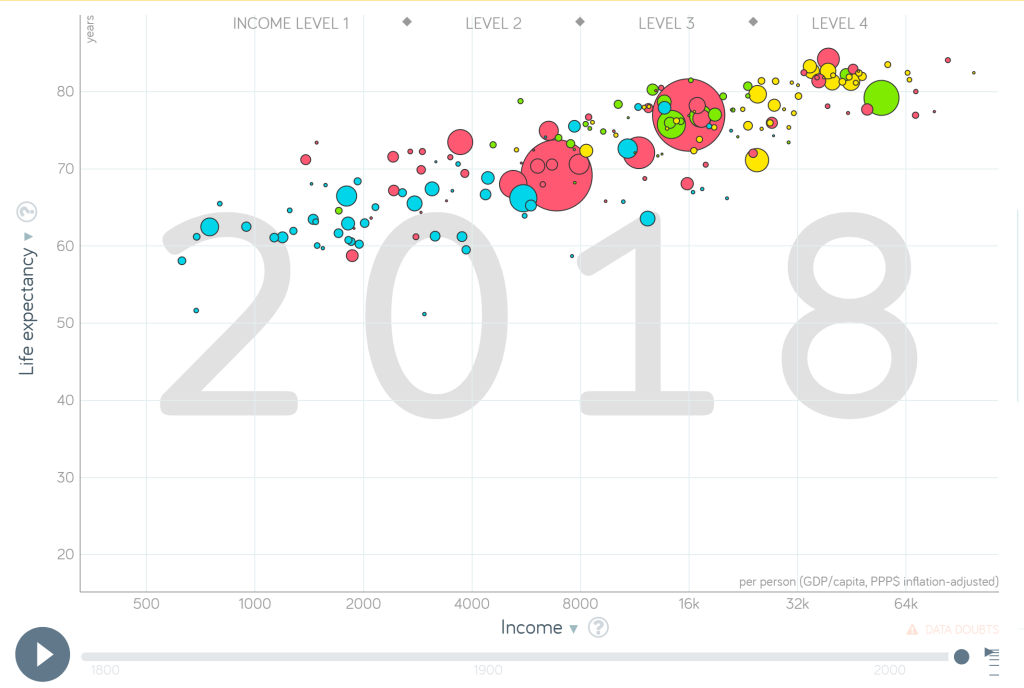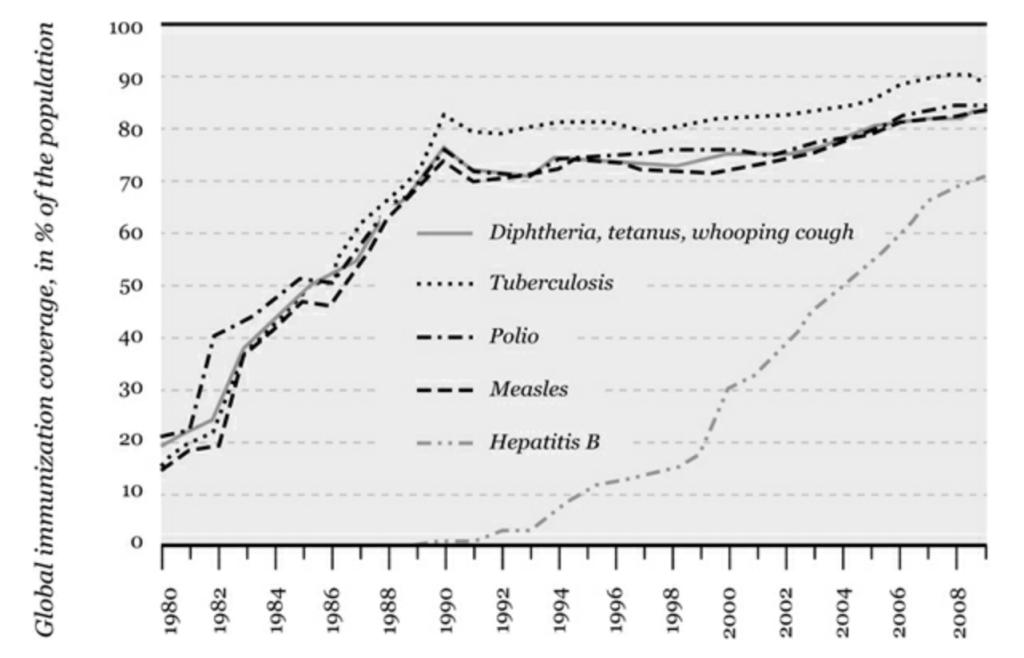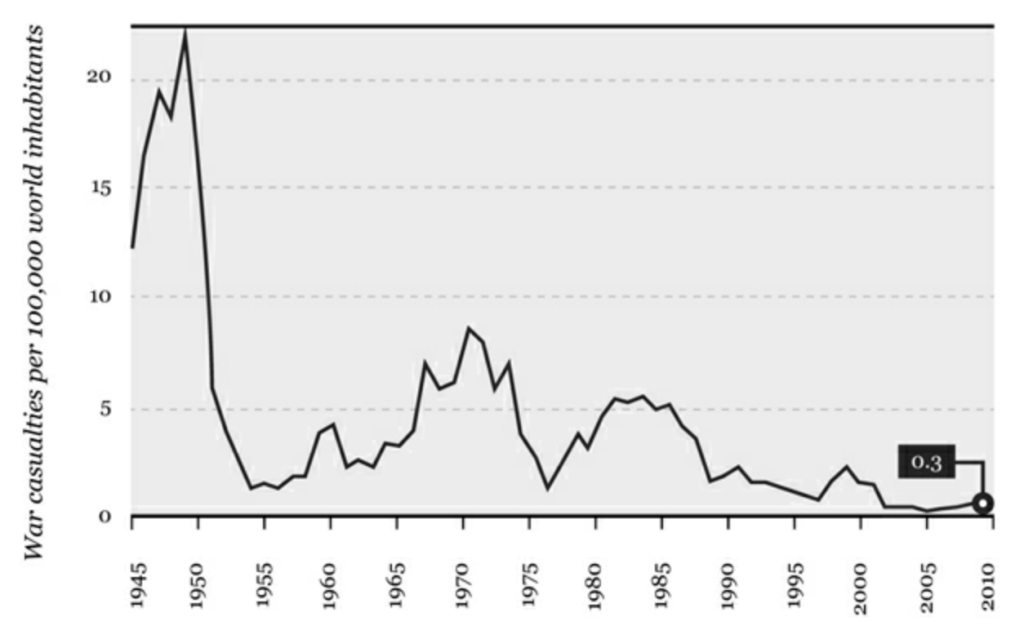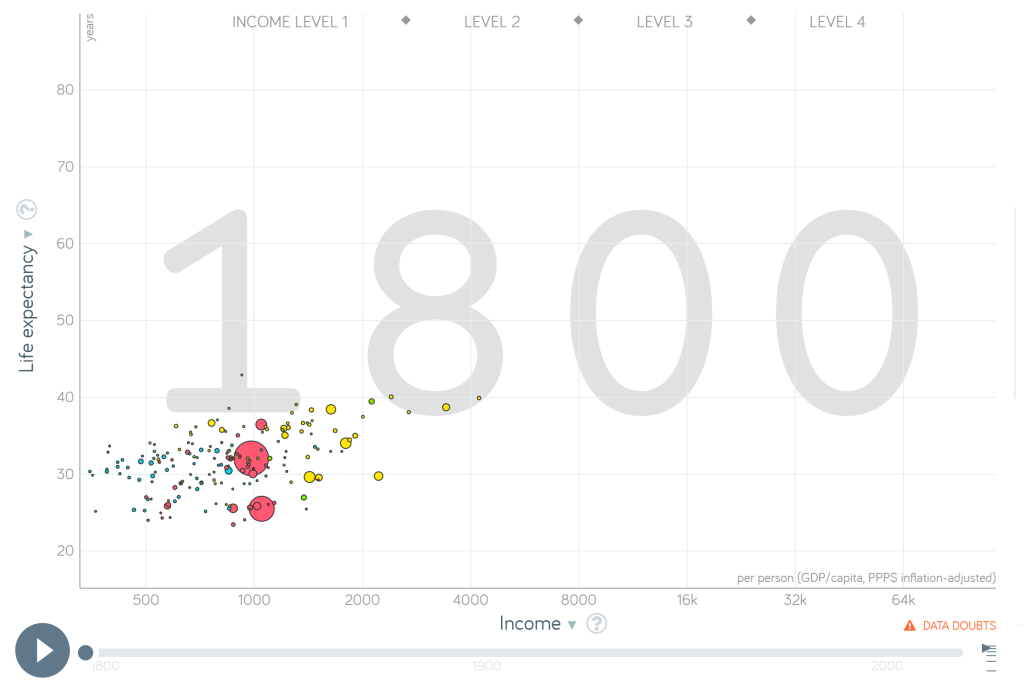Web Only
37
From the opening pages of Utopia for Realists.
Let’s start with a little history lesson:
In the past, everything was worse.
For roughly 99% of the world’s history, 99% of humanity was poor, hungry, dirty, afraid, stupid, sick, and ugly. As recently as the 17th century, the French philosopher Blaise Pascal (1623–1662) described life as one giant vale of tears. “Humanity is great,” he wrote, “because it knows itself to be wretched.” In Britain, fellow philosopher Thomas Hobbes (1588–1679) concurred that human life was basically “nasty, brutish, and short.”
But in the last 200 years, all of that has changed. In just a fraction of the time that our species has clocked on this planet, billions of us are suddenly rich, well nourished, clean, safe, smart, healthy, and occasionally even beautiful. Where 94% of the world’s population still lived in extreme poverty in 1820, by 1981 that percentage had dropped to 44%, and now, just a few decades later, it is under 10%.1
If this trend holds, the extreme poverty that has been an abiding feature of life will soon be eradicated for good. Even those we still call poor will enjoy an abundance unprecedented in world history. In the country where I live, the Netherlands, a homeless person receiving public assistance today has more to spend than the average Dutch person in 1950, and four times more than people in Holland’s glorious Golden Age, when the country still ruled the seven seas.2
For centuries, time all but stood still. Obviously, there was plenty to fill the history books, but life wasn’t exactly getting better. If you were to put an Italian peasant from 1300 in a time machine and drop him in 1870s Tuscany he wouldn’t notice much of a difference.

Historians estimate that the average annual income in Italy around the year 1300 was roughly $1,600. Some 600 years later – after Columbus, Galileo, Newton, the scientific revolution, the Reformation and the Enlightenment, the invention of gunpowder, printing, and the steam engine – it was… still $1,600.3 Six hundred years of civilization, and the average Italian was pretty much where he’d always been.
It was not until about 1880, right around the time Alexander Graham Bell invented the telephone, Thomas Edison patented his lightbulb, Carl Benz was tinkering with his first car, and Josephine Cochrane was ruminating on what may just be the most brilliant idea ever – the dishwasher – that our Italian peasant got swept up in the march of progress. And what a wild ride it has been. The past two centuries have seen explosive growth both in population and prosperity worldwide. Per capita income is now ten times what it was in 1850. The average Italian is 15 times as wealthy as in 1880. And the global economy? It is now 250 times what it was before the Industrial Revolution – when nearly everyone, everywhere was still poor, hungry, dirty, afraid, stupid, sick, and ugly.
The Medieval Utopia
The past was certainly a harsh place, and so it’s only logical that people dreamed of a day when things would be better.
One of the most vivid dreams was the land of milk and honey known as “Cockaigne.” To get there you first had to eat your way through three miles of rice pudding. But it was worth the effort, because on arriving in Cockaigne you found yourself in a land where the rivers ran with wine, roast geese flew overhead, pancakes grew on trees, and hot pies and pastries rained from the skies. Farmer, craftsman, cleric – all were equal and kicked back together in the sun.
In Cockaigne, the Land of Plenty, people never argued. Instead, they partied, they danced, they drank, and they slept around.
“To the medieval mind,” the Dutch historian Herman Pleij writes, “modern-day western Europe comes pretty close to a bona fide Cockaigne. You have fast food available 24/7, climate control, free love, workless income, and plastic surgery to prolong youth.”4 These days, there are more people suffering from obesity worldwide than from hunger.5 In Western Europe, the murder rate is 40 times lower, on average, than what it was in the Middle Ages, and if you have the right passport, you’re assured an impressive social safety net.6
Maybe that’s also our biggest problem: Today, the old medieval dream of the utopia is running on empty. Sure, we could manage a little more consumption, a little more security – but the adverse effects in the form of pollution, obesity, and Big Brother are looming ever larger. For the medieval dreamer, the Land of Plenty was a fantasy paradise – “An escape from earthly suffering,” in the words of Herman Pleij. But if we were to ask that Italian farmer back in 1300 to describe our modern world, his first thought would doubtless be of Cockaigne.
In fact, we are living in an age of Biblical prophecies come true. What would have seemed miraculous in the Middle Ages is now commonplace: the blind restored to sight, cripples who can walk, and the dead returned to life. Take the Argus II, a brain implant that restores a measure of sight to people with genetic eye conditions. Or the Rewalk, a set of robotic legs that enables paraplegics to walk again. Or the Rheobatrachus, a species of frog that went extinct in 1983 but, thanks to Australian scientists, has quite literally been brought back to life using old DNA. The Tasmanian tiger is next on this research team’s wish list, whose work is part of the larger “Lazarus Project” (named for the New Testament story of a death deferred).
Meanwhile, science fiction is becoming science fact. The first driverless cars are already taking to the roads. Even now, 3D printers are rolling out entire embryonic cell structures, and people with chips implanted in their brains are operating robotic arms with their minds. Another factoid: Since 1980, the price of 1 watt of solar energy has plummeted 99% – and that’s not a typo. If we’re lucky, 3D printers and solar panels may yet turn Karl Marx’s ideal (all means of production controlled by the masses) into a reality, all without requiring a bloody revolution.
For a long time, the Land of Plenty was reserved for a small elite in the wealthy West. Those days are over. Since China has opened itself to capitalism, 700 million Chinese have been lifted out of extreme poverty.7 Africa, too, is fast shedding its reputation for economic devastation; the continent is now home to six of the world’s ten fastest-growing economies.8 By the year 2013, six billion of the globe’s seven billion inhabitants owned a cell phone. (By way of comparison, just 4.5 billion had a toilet.)9 And between 1994 and 2014, the number of people with Internet access worldwide leaped from 0.4% to 40.4%.10
Also in terms of health – maybe the greatest promise of the Land of Plenty – modern progress has trumped the wildest imaginings of our ancestors. Whereas wealthy countries have to content themselves with the weekly addition of another weekend to the average lifetime, Africa is gaining four days a week.11 Worldwide, life expectancy grew from 64 years in 1990 to 70 in 201212 – more than double what it was in 1900.
Fewer people are going hungry, too. In our Land of Plenty we might not be able to snatch cooked geese from the air, but the number of people suffering from malnutrition has shrunk by more than a third since 1990. The share of the world population that survives on fewer than 2,000 calories a day has dropped from 51% in 1965 to 3% in 2005.13 More than 2.1 billion people finally got access to clean drinking water between 1990 and 2012. In the same period, the number of children with stunted growth went down by a third, child mortality fell an incredible 41%, and maternal deaths were cut in half.
And what about disease? History’s number one mass murderer, the dreaded smallpox, has been completely wiped out. Polio has all but disappeared, claiming 99% fewer victims in 2013 than in 1988. Meanwhile, more and more children are getting immunized against once-common diseases. The worldwide vaccination rate for measles, for example, has jumped from 16% in 1980 to 85% today, while the number of deaths has been cut by more than three-quarters between 2000 and 2014. Since 1990, the TB mortality rate has dropped by nearly half. Since 2000, the number of people dying from malaria has been reduced by a quarter, and so has the number of AIDS deaths since 2005.
Some figures seem almost too good to be true. For example, 50 years ago, one in five children died before reaching their fifth birthday. Today? One in 20. In 1836, the richest man in the world, one Nathan Meyer Rothschild, died due to a simple lack of antibiotics. In recent decades, dirt-cheap vaccines against measles, tetanus, whooping cough, diphtheria, and polio have saved more lives each year than world peace would have saved in the 20th century.14
Obviously, there are still plenty of diseases to go – cancer, for one – but we’re making progress even on that front. In 2013, the prestigious journal Science reported on the discovery of a way to harness the immune system to battle tumors, hailing it as the biggest scientific breakthrough of the year. That same year saw the first successful attempt to clone human stem cells, a promising development in the treatment of mitochondrial diseases, including one form of diabetes.
Some scientists even contend that the first person who will live to celebrate their 1,000th birthday has already been born.15
All the while, we’re only getting smarter. In 1962, 41% of kids didn’t go to school, as opposed to under 10% today.16 In most countries, the average IQ has gone up another three to five points every ten years, thanks chiefly to improved nutrition and education. Maybe this also explains how we’ve become so much more civilized, with the past decade rating as the most peaceful in all of world history. According to the Peace Research Institute in Oslo, the number of war casualties per year has plummeted 90% since 1946. The incidence of murder, robbery, and other forms of criminality is decreasing, too.

“The rich world is seeing less and less crime,” The Economist reported not long ago. “There are still criminals, but there are ever fewer of them and they are getting older.”17

A Bleak Paradise
Welcome, in other words, to the Land of Plenty.
To the good life. To Cockaigne, where almost everyone is rich, safe, and healthy. Where there’s only one thing we lack: a reason to get out of bed in the morning. Because after all, you can’t really improve on paradise. Back in 1989, the American philosopher Francis Fukuyama already noted that we had arrived in an era where life has been reduced to “economic calculation, the endless solving of technical problems, environmental concerns, and the satisfaction of sophisticated consumer demands.”18
Notching up our purchasing power another percentage point, or shaving a couple off our carbon emissions; perhaps a new gadget – that’s about the extent of our vision. We live in an era of wealth and overabundance, but how bleak it is. There is “neither art nor philosophy,” Fukuyama says. All that’s left is the “perpetual care-taking of the museum of human history.”
According to the Irish writer Oscar Wilde, upon reaching the Land of Plenty, we should once more fix our gaze on the farthest horizon and rehoist the sails. “Progress is the realization of Utopias,” he wrote. But the far horizon remains blank. The Land of Plenty is shrouded in fog. Precisely when we should be shouldering the historic task of investing this rich, safe, and healthy existence with meaning, we’ve buried utopia instead. There’s no new dream to replace it because we can’t imagine a better world than the one we’ve got. In fact, most people in wealthy countries believe children will actually be worse off than their parents.19
But the real crisis of our times, of my generation, is not that we don’t have it good, or even that we might be worse off later on.
No, the real crisis is that we can’t come up with anything better.
Notes
Extreme poverty means living on less than $1.25 a day, which is just enough to survive. See François Bourguignon and Christian Morrisson, “Inequality among World Citizens: 1820–1992,” The American Economic Review (September 2002). http://piketty.pse.ens.fr/files/BourguignonMorrisson2002.pdf
2. In the Netherlands, someone who is homeless receives around $10,000 a year in government assistance. The per capita GNP of 1950s Holland, corrected for purchasing power and inflation, was $7,408 (according to figures from gapminder.org). From 1600 to 1800, it was between $2,000 and $2,500.
3. See the figures presented by the historians Angus Maddison, J. Bolt, and J.L. van Zanden, “The First Update of the Maddison Project; Re-Estimating Growth Before 1820,” Maddison Project Working Paper 4 (2013). http://www.ggdc.net/maddison/maddison-project/home.htm
4. Herman Pleij, Dromen van Cocagne. Middeleeuwse fantasieën over het volmaakte leven (1997), p. 11.
5. World Health Organization, “Obesity and overweight,” Fact sheet No. 311 (March 2013). http://www.who.int/mediacentre/factsheets/fs311/en/
6. Manuel Eisner, “Long-Term Historical Trends in Violent Crime,” University of Chicago (2003), table 2. http://www.vrc.crim.cam.ac.uk/vrcresearch/paperdownload/manuel-eisner-historical-trends-in-violence.pdf
7. World Bank, “An update to the World Bank’s estimates of consumption poverty in the developing world” (2012). http://siteresources.worldbank.org/INTPOVCALNET/Resources/Global_Poverty_Update_2012_02-29-12.pdf
8. J.O.’s, “Development in Africa: Growth and other good things,” The Economist (May 1, 2013). http://www.economist.com/blogs/baobab/2013/05/development-africa
9. UN News Centre, “Deputy UN chief calls for urgent action to tackle global sanitation crisis” (March 21, 2013). http://www.un.org/apps/news/story.asp?NewsID=44452
10. According to figures from Internet Live Stats. See: http://www.internetlivestats.com
11. According to the World Health Organization, the average life expectancy in Africa for those born in 2000 was 50 years. In 2012, it was 58 years. http://www.who.int/gho/mortality_burden_disease/life_tables/situation_trends_text/en/
12. According to figures from the World Bank: http://apps.who.int/gho/data/view.main.700?lang=en
13. The individual average daily caloric intake rose from 2,600 in 1990 to 2,840 in 2012 (in Sub-Saharan Africa from 2,180 to 2,380). Miina Porka et al., “From Food Insufficiency towards Trade Dependency: A Historical Analysis of Global Food Availability,” Plos One (December 18, 2013). http://www.ncbi.nlm.nih.gov/pubmed/24367545
14. Bjørn Lomborg, “Setting the Right Global Goals,” Project Syndicate (May 20, 2014). https://www.project-syndicate.org/commentary/bj-rn-lomborg-identifies-the-areas-in-which-increased-development-spending-can-do-the-most-good
15. One is Audrey de Grey of Cambridge University, who gave a TED Talk on this topic: http://www.ted.com/talks/aubrey_de_grey_says_we_can_avoid_aging
16. Peter F. Orazem, “Challenge Paper: Education,” Copenhagen Consensus Center (April 2014). http://copenhagenconsensus.com/publication/education
17. “Where have all the burglars gone?” The Economist (July 18, 2013). http://www.economist.com/news/briefing/21582041-rich-world-seeing-less-and-less-crime-even-face-high-unemployment-and-economic
18. Francis Fukuyama, “The End of History?” The National Interest (Summer 1989). http://ps321.community.uaf.edu/files/2012/10/Fukuyama-End-of-history-article.pdf
Media Attributions
- brave_0JmKkm2yte
- brave_DYwQEfyHEd
- calibre-parallel_CkWyPyjxAx
- War has been on the decline Source: Peace Research Institute Oslo

